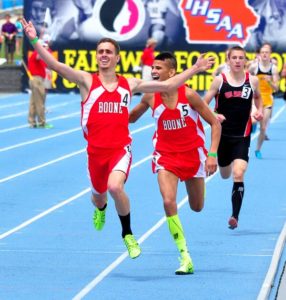Chandler Austin desperately wanted to break 5:00 for the mile. He was one of the top 8th grade runners in the state of Iowa. In his final middle school race, he took a shot at the time, but came up a few seconds short. 5:00 is certainly a solid performance for a middle school athlete, but not elite level by any stretch. Meanwhile, Chandler’s older brother, Brogan, was winning the state 1600 and 3200 meter runs as a high school senior. Brogan would later go on to be a multi-time conference champion for Drake University and eventually win the national marathon championship this past year. So what did 8th grade Chandler decide to do after coming up just short in his quest for sub-5:00? Let’s take a look at how the next 4 years unfolded:
XC: Fr – 16:25, So – 15:35, Jr – 15:20 (with mono), Sr – 15:05
Track 3200: Fr – 9:43, So – 9:23, Jr – 9:20, Sr – 8:51
Track 1600 – Fr – 4:41, So – 4:21, Jr – 4:15, Sr – 4:07
Every single season had better performances than the one before. Not an easy task when you consider the high-level performances of his freshman year. Ultimately that progression led to some of the fastest times in state history in all 3 events. Pretty savage indeed. What steps were taken to try to ensure the success of this progression?
1. He wanted to do it. Chandler never needed to be persuaded to show up for a workout. He told me his goals were to break the Iowa all-time records in XC (15:03), 3200 (9:04), and 1600 (4:09). Those were the goals he focused on as his guiding point even as a freshman.
2. Remain healthy. This is sometimes out of an athlete’s control, but steps can certainly be taken to reduce the risk, especially early on in high school training. Many coaches train all their athletes in grades 9-12 the same volume. It is foolish to assume a 14-year-old can do the same training as an 18-year-old who has been in the system for multiple years already. We started at 40 miles per week and added 5 to that number each off-season. There were ups and downs along the way, but his ability to remain mostly healthy was in large part due to the patient early approach and steady increase in load along the way.
3. Progressively tougher competition. As a freshman, he competed at the state meet and Drake Relays as his highest level of competition. In his sophomore year, he attended the Nike Cross Regional in the fall. In track his junior year he competed at the Midwest Distance Gala in the 1600. His senior year provided a whirlwind tour of some of the best meets around the country: Roy Griak Invitational in Minneapolis, Nike Cross Nationals in Portland, Festival of Miles in St. Louis, and Brooks PR Invitational in Seattle. As you can imagine, those competitions produced many of his personal best times. Just as an athlete must increase their training stimulus they must also increase the stimulus in their competitions. Chandler did not settle for being the top runner in Iowa. He slowly took on the challenge of tougher competition which pushed him to new heights in training and performance.

Chandler Austin and teammate Albert Meier finishing 1-2 in a state championship race for the fifth and final time in their high school careers.
There are many other scientific explanations that can be discussed about how he developed and how that compares to other athletes. At the end of the day, it came down to simple and steady progression to which his body responded well. Long-term success cannot be forced or rushed.
Have patience and trust your plans. Time can be your greatest training ally.
– Ben
Don’t forget to follow us on social media and sign-up for email updates to stay current on everything new with XLR8!

